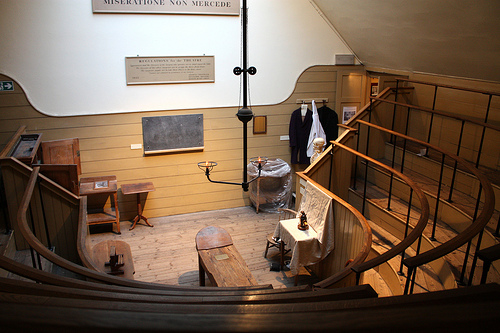The Old Operating Museum and Herb Garret
High in the roof space of an old English Church there is an old English operating theatre. This is not here for novelty value, nor has it been placed there for publicity purposes. It is what it is, an operating theatre. It can be found in the church of St Thomas in the borough of Southwark, just a little south of London Bridge. It may seem out of place here in the roof of a church, but when you understand the history of the place you will understand why it is there.

Why is there an Operating Theatre Inside a Church?
Originally the church of St Thomas was attached to the south wing of St Thomas Hospital; in fact the wards were built around it. Back in the day, the closest ward to the church was ‘Dorcas’ which was in fact the ladies surgical ward. To give you an impression of how things were before 1822, the surgical ward was just that. The women that needed operations of any sort would be operated on in their bed on the ward, bearing in mind that they were Nightingale wards with many beds, this would not only be a life threatening event for the patient in question but the ‘treatment’ was more than just a little traumatic for the other ladies on the ward.
This procedure of in-situ operations had been practiced for some considerable time, but when the Apothecary’s Act was passed in 1815 it meant that the surgical wards became more crowded as apprentice apothecaries were required to observe the operations taking place. By relocating the area of surgery to the herb garret in the roof of the church this offered room for the students to observe and provided some relief from the horrors of surgery that patients had previously been forced to witness. This new operating theatre was purposely built with a skylight being installed in the church roof. With no ventilation and no form it of heating it was not the most pleasant of venues but it was a leap forward in ‘patient care’.
Pioneering Surgery or Butchery?
Up until 1847 surgeons had to rely on their speed and accuracy in performing procedures. The new operating theatre did offer some sound proofing from the rest of the wards, as the screams of the surgeon’s patient were blood curdling in the extreme. With the introduction of anaesthetics in 1847 things became a lot quieter. This operating theatre was mainly used for amputations and minor surgical procedures. A good surgeon could remove a leg in a matter of minutes for even the most ‘reluctant’ of patients. It was still for too dangerous to perform any internal surgery as this was before the introduction of antiseptic and sterile environments. The operating theatre closed down however before antiseptic surgery was commonplace in hospitals.
The Herb Garret
The church of St Thomas was rebuilt in 1703 with a purposely large roof space which was used the hospitals apothecaries for storing and using their medicinal herbs. The space proved to be an excellent storage area as the rats were less prone to visit, preferring instead the dark and dank basement areas. Plus the large wooden rafters that supported the roof were good at absorbing moisture from the fresh herbs.

